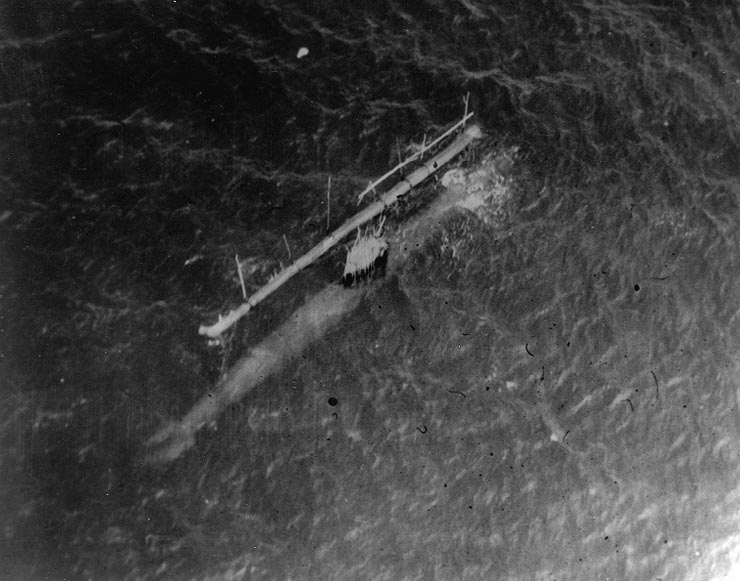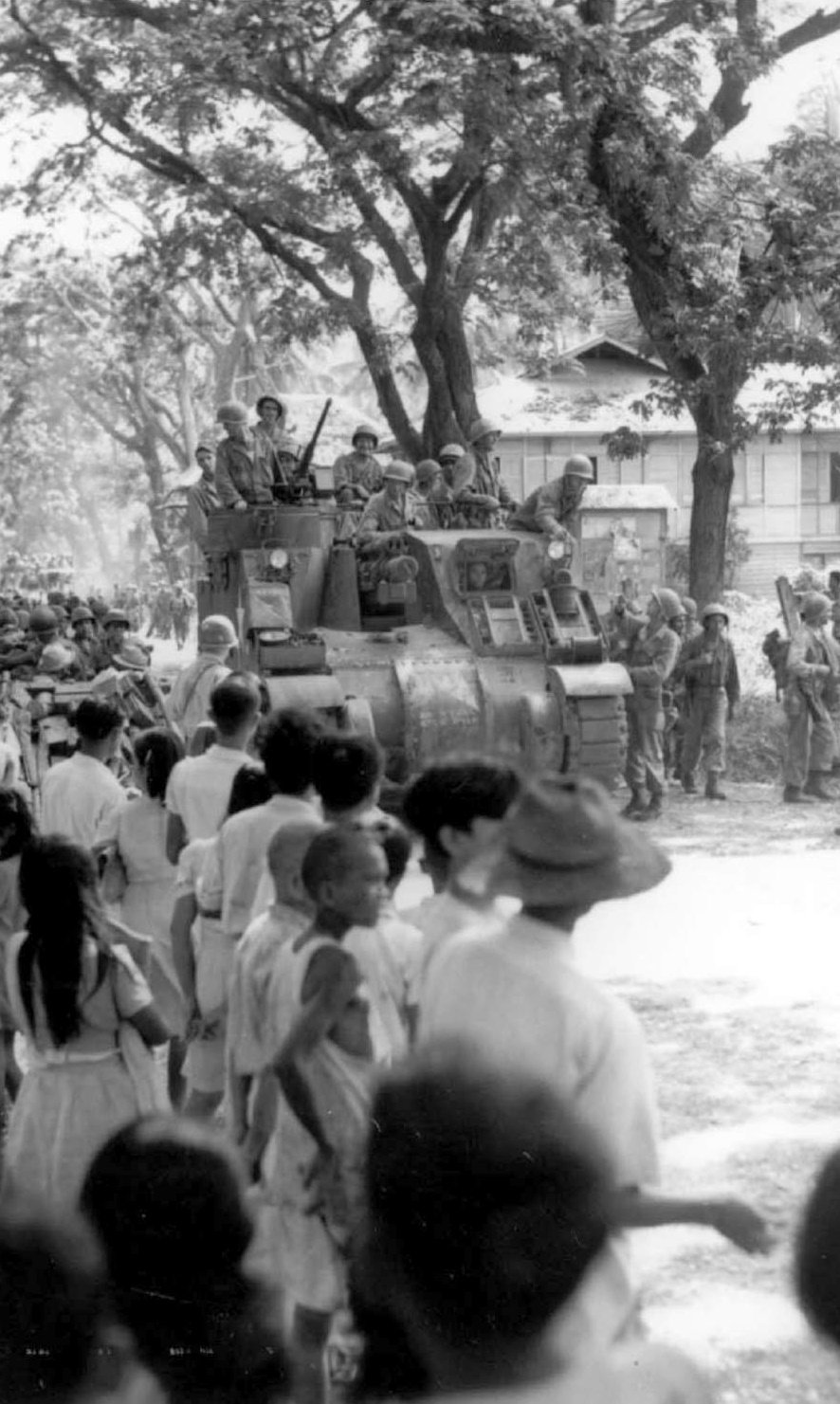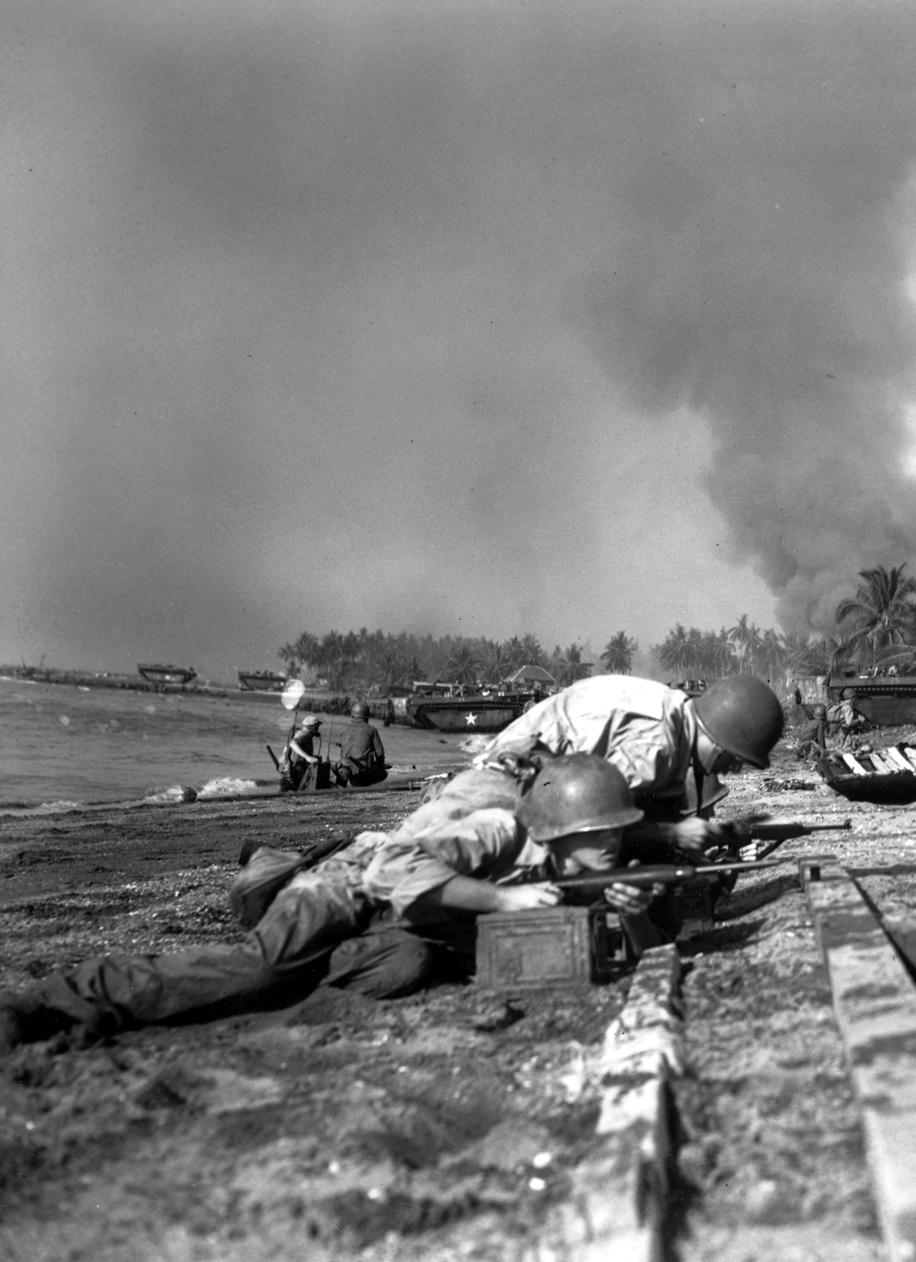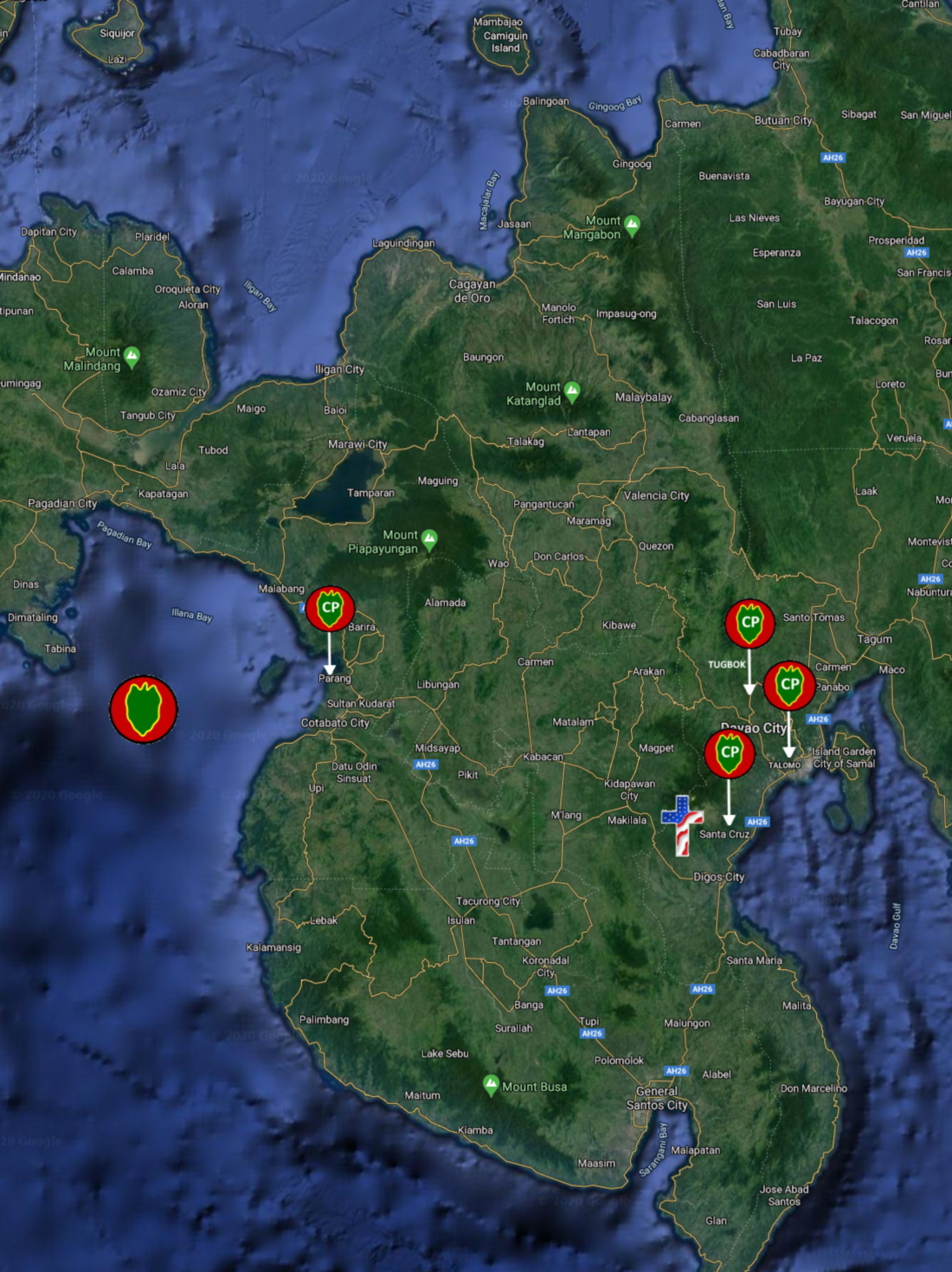 By May 4, the city was secure and the regiment returned to complete the time-consuming task of clearing all the high ground around the city. With the capture of Davao, the main tactical objective of the division had been accomplished but the mission of pursuing and destroying the enemy in the mountains still remained. Something to be noted is that the 140-mile march from Parang to Davao was completed in fifteen days. At this point, the division was ordered to conduct strong recon towards the Kibawe Pass and to gain contact with the guerrilla forces at the head of the Davao Gulf. The latter mission required a long advance and was a dispersion of forces from the main military operation. However, the 19-RCT was ordered to continue up the gulf from Davao to meet the guerrilla elements. After this was accomplished it was planned that the entire division effort would be turned up the Kibawe Road where the main Jap positions were now believed, to be located.
By May 4, the city was secure and the regiment returned to complete the time-consuming task of clearing all the high ground around the city. With the capture of Davao, the main tactical objective of the division had been accomplished but the mission of pursuing and destroying the enemy in the mountains still remained. Something to be noted is that the 140-mile march from Parang to Davao was completed in fifteen days. At this point, the division was ordered to conduct strong recon towards the Kibawe Pass and to gain contact with the guerrilla forces at the head of the Davao Gulf. The latter mission required a long advance and was a dispersion of forces from the main military operation. However, the 19-RCT was ordered to continue up the gulf from Davao to meet the guerrilla elements. After this was accomplished it was planned that the entire division effort would be turned up the Kibawe Road where the main Jap positions were now believed, to be located.
Commencing May 17, the 19-RCT moved slowly north of Davao due to vigorous enemy activity in the form of infiltration and defensive tactics of employing heavy mines and Bangalore torpedoes on all roadways. Jap naval troops defending this sector proved to be aggressive in the matter of counterattacks and in ambushes. The 19-RCT continued to make slow steady progress and finally, their patrols contacted the guerrillas on May 24 in the vicinity of the Tagum River at the head of the Davao Gulf. This was a distance of 24 miles from Davao City. After contact was made the regiment turned west from Panacan on the coast into the hills to advance on the Mandog Area. It was expected that the strongest resistance of the Jap naval forces would be met in this area. The Mandog Area was northwest of Mintal where the 21-RCT was deeply involved at this time.
 Returning to the situation of the 21-RCT in the vicinity of Mintal at this time, it was apparent that this unit had a task beyond the capabilities of a force of this size. As elements of the 34-RCT completed their mission in the Guma-Digos Area they were shifted northeast battalion by battalion to the right of the 21-RCT to strengthen that position. The situation now developing indicated great Jap strength north of Mintal. More captured plans indicated that this was the western abutment of the Jap main defensive line facing the Davao Gulf. The enemy in this vicinity fought well, took heavy losses, and was not afraid to act aggressively. At this time the combat team formations were dropped with the artillery battalions reverting to general support under the Division Artillery. This had not been feasible prior to this time due to the rapidity of movement and isolated nature of operations of each separate infantry regiment. In this area in which the division has now employed a type of vegetation was encountered that proved to be a great handicap for the balance of the campaign. It was the abaca or hemp plant from which the famous Manila rope is made. It resembles the banana plant but sometimes grows to a height of twenty feet. The area from Daliao north and northwest was under extensive cultivation with abaca. War conditions prevented normal harvesting and the vast fields were quickly overgrown until the stalks at times were nearly a foot in diameter and no more than a foot apart. Lead infantry scouts operating in this country were frequently fired upon at ranges of no more than five yards with no one being able to observe the fire. The Jap made the most of this heavy growth for ambushes.
Returning to the situation of the 21-RCT in the vicinity of Mintal at this time, it was apparent that this unit had a task beyond the capabilities of a force of this size. As elements of the 34-RCT completed their mission in the Guma-Digos Area they were shifted northeast battalion by battalion to the right of the 21-RCT to strengthen that position. The situation now developing indicated great Jap strength north of Mintal. More captured plans indicated that this was the western abutment of the Jap main defensive line facing the Davao Gulf. The enemy in this vicinity fought well, took heavy losses, and was not afraid to act aggressively. At this time the combat team formations were dropped with the artillery battalions reverting to general support under the Division Artillery. This had not been feasible prior to this time due to the rapidity of movement and isolated nature of operations of each separate infantry regiment. In this area in which the division has now employed a type of vegetation was encountered that proved to be a great handicap for the balance of the campaign. It was the abaca or hemp plant from which the famous Manila rope is made. It resembles the banana plant but sometimes grows to a height of twenty feet. The area from Daliao north and northwest was under extensive cultivation with abaca. War conditions prevented normal harvesting and the vast fields were quickly overgrown until the stalks at times were nearly a foot in diameter and no more than a foot apart. Lead infantry scouts operating in this country were frequently fired upon at ranges of no more than five yards with no one being able to observe the fire. The Jap made the most of this heavy growth for ambushes.
Beginning with the Digos, the Mintal, and the Davao‘s actions casualties in all combat elements of the division continued to be heavy due to tough progress in the thick abaca fields as well as the close proximity to the main Jap positions. By the end of May, the infantry battalions were understrength approximately 400 men each. One shipment of approximately 2500 replacements was received at this time but the understrength obviously continued to be a real problem.

 Earlier on May 11, the 3/163-IR, 41-ID, from Zamboanga was attached to the division as a small added source of strength. Initially, this battalion released division combat troops guarding rear installations in the Davao Area. Later, due to continuing loss of strength, it was necessary to commit this battalion as well as the 162-RCT of the same 41-ID which had arrived from Zamboanga and was also subsequently attached to the 24-ID to bolster the depleted division strength during the latter part of May. The division plan of attack now was to proceed up the Mintal – Ula – Calinan Road with two regiments abreast to get at the main Jap positions. Meanwhile, the 19-RCT was reducing the naval garrison to the northeast in the Mandog Area and would be employed with the other two regiments as soon as possible for a coordinated effort. Due to a critical understrength, it was necessary that the 21-RCT be withdrawn and placed in a rear area rest camp at this time. Thus the attack continued with the 34-RCT and the 162-RCT reinforced by the 3/163-RCT pushing up the Ula – Calinan Road. The terrain at this stage was particularly rough with the advance heading directly into the formidable obstacle of Mount Manoy, located just beyond the village of Calinan. Due to the extreme nature of the terrain, this could not be avoided. The nature of this fighting was typical of all Pacific Operations against the Jap. Battalions of infantry regiments fought practically independent actions supported and tied in with fire plans of supporting weapons and artillery.
Earlier on May 11, the 3/163-IR, 41-ID, from Zamboanga was attached to the division as a small added source of strength. Initially, this battalion released division combat troops guarding rear installations in the Davao Area. Later, due to continuing loss of strength, it was necessary to commit this battalion as well as the 162-RCT of the same 41-ID which had arrived from Zamboanga and was also subsequently attached to the 24-ID to bolster the depleted division strength during the latter part of May. The division plan of attack now was to proceed up the Mintal – Ula – Calinan Road with two regiments abreast to get at the main Jap positions. Meanwhile, the 19-RCT was reducing the naval garrison to the northeast in the Mandog Area and would be employed with the other two regiments as soon as possible for a coordinated effort. Due to a critical understrength, it was necessary that the 21-RCT be withdrawn and placed in a rear area rest camp at this time. Thus the attack continued with the 34-RCT and the 162-RCT reinforced by the 3/163-RCT pushing up the Ula – Calinan Road. The terrain at this stage was particularly rough with the advance heading directly into the formidable obstacle of Mount Manoy, located just beyond the village of Calinan. Due to the extreme nature of the terrain, this could not be avoided. The nature of this fighting was typical of all Pacific Operations against the Jap. Battalions of infantry regiments fought practically independent actions supported and tied in with fire plans of supporting weapons and artillery.
By June 16, it was evident that although the Jap was still delaying fiercely, his communications and command had begun to disintegrate under the pressure of the continuing attack. On June 19, the 19-RCT joined the action after turning the final Mandog Area mop-up to guerrilla forces. This provided a final three-regiment assault on the Jap positions. In the last week of June, about 2000 more replacements were received to further strengthen the organization. By the time the advance troops approached Mount Manoy, the Jap forces were in remnants and were in full retreat to the high mountains to the west. Elements of two regiments continued the pursuit through the Manoy Pass as far as Kibangay which was found to be the forward limit of jeep traffic under existing weather conditions in the hills. Roadblocks and heavy patrolling were continued here with no particular effort being made to advance further into the mountains. Disorganized and without supplies the remnants of the Jap forces were bottled up in the mountains until V-J Day on September 2, 1945.
As compared to the fast move across Mindanao which was accomplished in approximately twelve days, the action in the Davao Gulf area required sixty days of hard fighting in unfavorable terrain against a fanatical enemy with an additional sixty days mopping up period that continued until V-J Day. Although the Victor V operation officially terminated on June 30, 1945, for practical purposes it did not end until V-J Day. One additional major operation was staged after June 30 by the 24-ID in Mindanao. A provisional amphibious task force was sent south to the Sarangani Bay area to destroy scattered enemy groups in that region.
 The Jap had garrisoned this area heavily early in the war but most of the troops were later shifted to Leyte, Davao and Digos. The Sarangani Task Force consisted of a heavily reinforced battalion of the 21st Infantry Regiment (24-ID), a guerrilla battalion, and portions of a US AAA Group functioning as infantry. The battalion of the 21-IR landed amphibiously on July 12, 1945, in the Sarangani Bay area from Talomo while the guerrillas and the AAA infantrymen marched overland front the north. These three forces conducted vigorous patrolling actions and destroyed small enemy forces in this area from July 12 to August 11, 1945, when the operation was considered completed. 444 Japs were killed during this period with a task force loss of 14 killed and 15 wounded.
The Jap had garrisoned this area heavily early in the war but most of the troops were later shifted to Leyte, Davao and Digos. The Sarangani Task Force consisted of a heavily reinforced battalion of the 21st Infantry Regiment (24-ID), a guerrilla battalion, and portions of a US AAA Group functioning as infantry. The battalion of the 21-IR landed amphibiously on July 12, 1945, in the Sarangani Bay area from Talomo while the guerrillas and the AAA infantrymen marched overland front the north. These three forces conducted vigorous patrolling actions and destroyed small enemy forces in this area from July 12 to August 11, 1945, when the operation was considered completed. 444 Japs were killed during this period with a task force loss of 14 killed and 15 wounded.
 G-1 Operations
G-1 Operations
March across Mindanao
Elements of the division command post in the assault echelon commenced landing on the Parang Beach on R Day at H Hour plus 20 minutes (0920 April 17, 1945) from their several amphibious craft as originally planned. The CP group assembled in a coconut grove about 1000 yards inland from the beach and next to the 19-RCT’s CP, the assault regiment. By 1100, all personnel and vehicles of the division CP assault echelon had landed and assembled in the grove ready for operations. At this time a command decision was rendered that the CP could be established in this area until the R Day progress of the infantry regiments could be determined. The organization of the CP area was made immediately by the G-1 and the Headquarters Commandant. Tentage was pitched and staff sections commenced operations without delay. The composition of the CP followed the discussion earlier in the G-1 planning phase of this monograph with the addition of a signal detachment of 75 men and officers from the 24-Sig Co and the 24-MP Plat (-) consisting of 50 men and officers. These two detachments normally moved with the division CP. The headquarters SOP provided that these detachments join the command group immediately after debarking from their respective vessels in an amphibious operation.
The layout of the command post was affected by the HQs’ Commandant with his plan following SOP standards of the division. This required only nominal coordination and supervision by the G-1. Due to the constant threat of Jap infiltration in any operation, the CP area was purposely kept small and compact at all times in order that CP personnel could establish an effective perimeter defense. All personnel was utilized for perimeter defense including clerks of each staff section on a shift basis. G-1 activities on R Day in addition to coordination of details of the CP interior arrangement and defense with the HQ’s Commandant were primarily concerned with securing accurate initial strength and casualty reports from organic and attached units of the division. This was difficult due to the unsettled tactical situation and the fact that many units had not yet landed. Only a minimum amount of communications had been established which delayed securing these reports for some time. A complete report was not available due to these circumstances until R +2 Days. On the morning of R +2 Days, the balance of the division CP personnel joined the command group when the reserve RCT convoy landed at Parang.
Early in the advance across the island, it was evident that the division CP must displace rapidly and frequently in order to maintain effective communications with the leading infantry units. Commencing with the initial displacement from the beachhead forward on R +2 Days the CP displaced forward on an average of once each 36 hours to maintain control of its units. This rapid CP movement, keeping pace with the advancing troops, did not slow down until the arrival of the elements of the 19-RCT in the Davao area on May 2, 1945. This was approximately two weeks after the initial assault landing. At this time the division CG made a decision to locate his HQs at Talomo which possessed an excellent beach and harbor. The Talomo Area was subsequently developed into an HQ site and supply base which served the division adequately for the balance of the Mindanao operation. This was a fortunate decision as it was later determined that the port facilities of Davao were useless due to the destruction by the enemy prior to their withdrawal and previous bombings by our air force.
 Displacement forward of the division command post was extremely difficult at this time due to the many destroyed bridges and rugged terrain. When road and bridge conditions immobilized 2.5-ton trucks from time to time this situation was met by forming a stripped CP consisting only of a minimum number of essential staff officers representing the General Staff with the commander going forward to be in contact with the lead regiments. This small group utilizing only jeeps and 1/4 ton trailers was able to operate forward in most instances with a minimum of equipment. The bulkier vehicles and equipment followed when the roads and bridges could accommodate them.
Displacement forward of the division command post was extremely difficult at this time due to the many destroyed bridges and rugged terrain. When road and bridge conditions immobilized 2.5-ton trucks from time to time this situation was met by forming a stripped CP consisting only of a minimum number of essential staff officers representing the General Staff with the commander going forward to be in contact with the lead regiments. This small group utilizing only jeeps and 1/4 ton trailers was able to operate forward in most instances with a minimum of equipment. The bulkier vehicles and equipment followed when the roads and bridges could accommodate them.
During the period of rapid advance from Parang to Talomo, the G-1 Section was primarily concerned with CP organization, protection, and displacement with the HQ Commandant, and the rendering of strength and casualty reports daily to G-1, X Corps. Due to the very nature of the fluid situation, no other G-1 business of importance could be easily transacted during this time. The rear echelons containing the various unit personnel sections had not yet arrived from Mindoro with the detailed personnel records. Due to the continuous daily movement forward very little paperwork other than the necessary recurring combat reports was prepared due to lack of time. Obtaining the daily strength and casualty reports during this period was a difficult proposition due to the lack of adequate communications and the constant movement of units. Consequently, many times incomplete reports by necessity were given to G-1, X Corps in the daily summary of strength and casualties. During this phase, the daily summary was normally submitted as of 1800 hours by telephone or radiotelephone in code. When communications with Corps failed due to being out of transmission range of wire and radio, a radiogram would be filed for immediate transmission when service was restored.
Recon for new command post sites was performed jointly by the G-1, HQs Commandant, and a representative of the Signal Officer. Early in the advance, military maps proved highly inaccurate and prevented any detailed locations from being selected from map studies. As the division worked inland the map inaccuracies increased as large portions of the un-mapped territory were traversed. Aerial photo coverage was poor due to poor weather at this time of year. This, as in other military situations, required personal recon of the ground under consideration. Once a suitable site was selected by the G-1, the HQ Commandant would complete the layout of the ground and signal communications would be installed prior to the move of the first echelon of the CP. In every instance, it was necessary for the HQ Company defense platoon to thoroughly search the new site for Jap snipers or infiltrators before work could be initiated in the new location.
During the Pacific operations, the T/0 strength of the HQ Co defense platoon was not sufficient to adequately perform the security mission in close tropical terrain. To correct this situation an over-strength of approximately 30 men was authorized on a detached service basis from the infantry regiments. This overstrength was composed of older battle-fatigued enlisted men whose value to the regiments during heavy operations was questionable. Due to the relatively light workload within the G-1 section during the advance across the island, the Chief of Staff assigned various miscellaneous tasks to the officers of the section as the need arose from time to time. Many times these missions were out of the realm of military personnel work. These missions were of an operating nature and included a host of miscellaneous activities including inspections of supply dumps, liaison visits, and traffic control missions at various critical points along the route of advance. On reaching the Davao Gulf the division CP advanced to the north directly behind the 19-RCT, then the leading infantry unit. The CP followed this regiment as far as Santa Cruz where it stopped for approximately 48 hours. During this time the necessary work was done for the establishment of the temporary base for supplies to arrive by water from Parang in addition to other normal CF duties. The G-1 was active at this point in establishing a division military cemetery at Santa Cruz adjacent to the civilian cemetery already existing. This was the first division cemetery to be established during the operation. The matter of graves registration will be covered in a paragraph to follow.
From Santa Cruz, the CP displaced north a few miles to Talomo where it was permanently located for the balance of the operation except for a few days in the latter part of June. At this time an advanced CP functioned at Tugbok for approximately ten days when the final drive was made on the main Jap positions in the Mount Manoy area. As soon as the tactical situation slowed down the CP likewise stabilized at Talomo. This enabled the G-1 Section to assume its prescribed role in staff functioning in the division personnel matters. In the course of a few days, time after the arrival of the CP at Talomo the rear echelon arrived at Talomo about May 5 after making a combination water and overland move from Parang. Consolidation of both rear and forward echelons of the division headquarters at Talomo proved to be a fortunate arrangement that expedited the preparation and transmission of all types of administrative reports which otherwise would have been delayed.






















